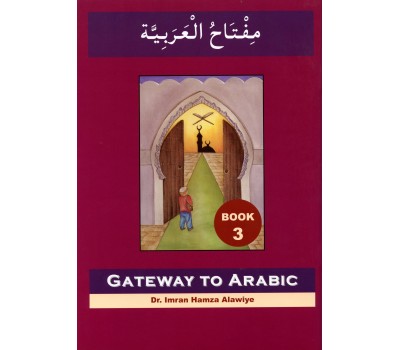Gateway to Arabic: Book 3
- Publisher: Anglo-Arabic Graphics Ltd
- Product Code: BK2444
- Availability: In Stock
- Book Binding: Paper Back
- Book Author: Dr Imran H. Alawiye
-
£4.50
Book Three offers a step-by-step approach to learning past and present tense verbs, with plenty of opportunity for practice. Each point of grammar is reinforced through sample conversations that offer the student the chance to use the language in a meaningful context and develop confidence in self-expression.
This book covers:
* Over 60 past and present tense verbs
* The imperative and negative imperative
* The nominative, accusative and genitive cases, including the genitive of possession (idafa)
* Comparative and superlative adjectives
* Attached and detached pronouns
* Word roots and word patterns
* Cardinal numbers from 1 to 19 and ordinal numbers from 1 to 10, and the rules governing their usage
* Prepositions
* Dialogue practice
* A comprehensive listing of the nouns used in the book, together with their plural forms
* A list of the past tense verbs used in the book, together with their present tense forms
More Description By author Dr Imran Alawiye for gatewaytoarabic.com
The materials in Book Three and upwards are best used with secondary school students or above – I would suggest a minimum age of eleven upwards. The primary objective of Book Three is to introduce students to regular triliteral first form Arabic verbs in the past and present tenses.
(Page 12) Here, having learnt to conjugate the verb ‘he wrote’ (kataba), students are given the opportunity to conjugate ‘he studied’ (darasa) and ‘he drank’ (shariba) for themselves. The concept of word patterns and word roots is also introduced in this book, as is the correct word order for verbal sentences and the agreement of verbs and number.
(Page 17) Students are also taught noun and adjective endings in the nominative, accusative and genitive cases in their defined and indefinite forms, as well as their usage in sentences. The use of the genitive to express possession (idaafah) is explored in some depth.
Other areas covered by this book include the attached and detached pronouns, comparative and superlative adjectives, cardinal numbers up to nineteen and ordinal numbers from one to ten; and the construction and use of the imperative. One of the key new areas of vocabulary introduced is the school timetable.
.jpg)
